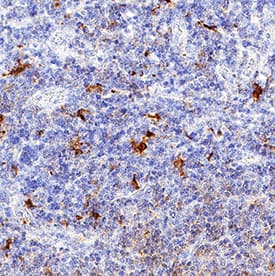Human CD28 Antibody
R&D Systems, part of Bio-Techne | Catalog # AF-342-PB


Key Product Details
Species Reactivity
Validated:
Cited:
Applications
Validated:
Cited:
Label
Antibody Source
Product Specifications
Immunogen
Asn19-Pro152
Accession # P10747
Specificity
Clonality
Host
Isotype
Endotoxin Level
Scientific Data Images for Human CD28 Antibody
Human CD28 Antibody Enhances IL-2 Secretion in Jurkat Cells.
Human CD28 Antigen Affinity-purified Polyclonal Antibody enhances IL-2 secretion in Jurkat human acute T cell leukemia cell line stimulated with 10 ng/mL phorbol myristate acetate (PMA) and 0.5 µM calcium ionophore, in a dose-dependent manner, as measured using the Quantikine Human IL-2 ELISA Kit (Catalog # D2050). The ED50 for this effect is typically 0.3-0.6 µg/mL.CD28 in Human PBMCs.
CD28 was detected in immersion fixed human peripheral blood mononuclear cells (PBMCs) using 10 µg/mL Goat Anti-Human CD28 Antigen Affinity-purified Polyclonal Antibody (Catalog # AF-342-PB) for 3 hours at room temperature. Cells were stained with the NorthernLights™ 557-conjugated Anti-Goat IgG Secondary Antibody (red; Catalog # NL001) and counter-stained with DAPI (blue). View our protocol for Fluorescent ICC Staining of Non-adherent Cells.CD28 in Human Tonsil.
CD28 was detected in immersion fixed paraffin-embedded sections of human tonsil using Goat Anti-Human CD28 Antigen Affinity-purified Polyclonal Antibody (Catalog # AF-342-PB) at 3 µg/mL for 1 hour at room temperature followed by incubation with the Anti-Goat IgG VisUCyte™ HRP Polymer Antibody (VC004). Tissue was stained using DAB (brown) and counterstained with hematoxylin (blue). Specific staining was localized to cell surfaces in lymphocytes. View our protocol for IHC Staining with VisUCyte HRP Polymer Detection Reagents.Applications for Human CD28 Antibody
Agonist Activity
Sample: Jurkat human acute T cell leukemia cell line
CyTOF-ready
Flow Cytometry
Sample: Human whole blood CD3+ T cells
Immunocytochemistry
Sample: Immersion fixed human peripheral blood mononuclear cells (PBMCs)
Immunohistochemistry
Sample: Immersion fixed paraffin-embedded sections of human tonsil
Reviewed Applications
Read 2 reviews rated 4 using AF-342-PB in the following applications:
Formulation, Preparation, and Storage
Purification
Reconstitution
Formulation
Shipping
Stability & Storage
- 12 months from date of receipt, -20 to -70 °C as supplied.
- 1 month, 2 to 8 °C under sterile conditions after reconstitution.
- 6 months, -20 to -70 °C under sterile conditions after reconstitution.
Background: CD28
CD28 and CTLA-4, together with their ligands, B7-1 and B7-2, constitute one of the dominant costimulatory pathways that regulate T and B cell responses. CD28 and CTLA-4 are structurally homologous molecules that are members of the immunoglobulin (Ig) gene superfamily. Both CD28 and CTLA-4 are composed of a single Ig V‑like extracellular domain, a transmembrane domain and an intracellular domain. CD28 and CTLA-4 are both expressed on the cell surface as disulfide-linked homodimers or as monomers. The genes encoding these two molecules are closely linked on human chromosome 2 and mouse chromosome 1. Mouse CD28 is expressed constitutively on virtually 100% of mouse T cells and on developing thymocytes. Cell surface expression of mouse CD28 is down-regulated upon ligation of CD28 in the presence of PMA or PHA. In contrast, CTLA-4 is not expressed constitutively but is up-regulated rapidly following T cell activation and CD28 ligation. Cell surface expression of mouse CTLA-4 peaks approximately 48 hours after activation. Although both CTLA-4 and CD28 can bind to the same ligands, CTLA-4 binds to B7-1 and B7-2 with a 20-100 fold higher affinity than CD28. CD28/B7 interaction has been shown to prevent apoptosis of activated T cells via the upregulation of Bcl-xL. CD28 ligation has also been shown to regulate Th1/Th2 differentiation.
References
- Lenschow, D.J. et al. (1996) Annu. Rev. Immunol. 14:233.
- Hathcock, K.S. and R.J. Hodes (1996) Advances in Immunol. 62:131.
- Ward, S.G. (1996) Biochem. J. 318:361.
Alternate Names
Gene Symbol
UniProt
Additional CD28 Products
Product Documents for Human CD28 Antibody
Product Specific Notices for Human CD28 Antibody
For research use only

